It’s been interesting to note some different species of fungi growing on the property this winter, compared to last year. We haven’t seen a single Redwood Rooter or Elfin Saddle yet this year, but instead, we seem to have a number of Lactarius species that we didn’t notice at all last winter.
This west coast species, Lactarius xanthogalactus, has been especially prevalent throughout our oak woodlands on the property this year. Commonly known as the West-Coast Milky Cap, Lactarius xanthogalactus is typically found growing in association with Coast Live Oak. It may be found growing alone, scattered, or gregariously during the fall and winter months.
The cap of this species ranges from 4-12 cm in diameter, is broadly convex, to plane, and occasionally shallowly vase-shaped, in more mature specimens, like the one below.
The central disc is often depressed, and the cap margin is incurved, becoming decurved with age. The gills are attached to slightly decurrent, narrow, and often forked near the stem.
The cap surface is somewhat viscid when moist, glabrous, and is colored a reddish brown, sometimes with darker spotting.
The stipe (stem) is typically 2-8 cm in length, hollow at the apex and solid, often with a slight flare, at the base. The cortex, when injured, exudes a white latex that rapidly turns sulfur-yellow on exposure to air.
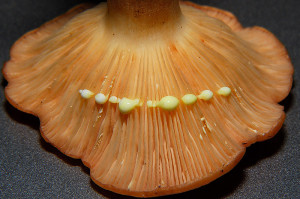
Injured cortical tissue exudes a milky white latex, that within just a few seconds becomes sulfur-yellow
This species has a pale yellow spore print.
Although some Lactarius sp. are edible, Lactarius xanthogalactus is considered poisonous, and most mushroom guides as a general rule recommend avoiding consumption of any Lactarius species with latex that turns yellow.
After a soggy start to winter, we’ve now had a couple of weeks of dry sunny weather, and our woodlands are drying out quickly. This morning’s hike around the property turned up very few species of fungi compared to recent weeks. With more sun in the long-range forecast, Mushroom Mondays may get cut short this season…but the good news is, it’s perfect weather for gardening!

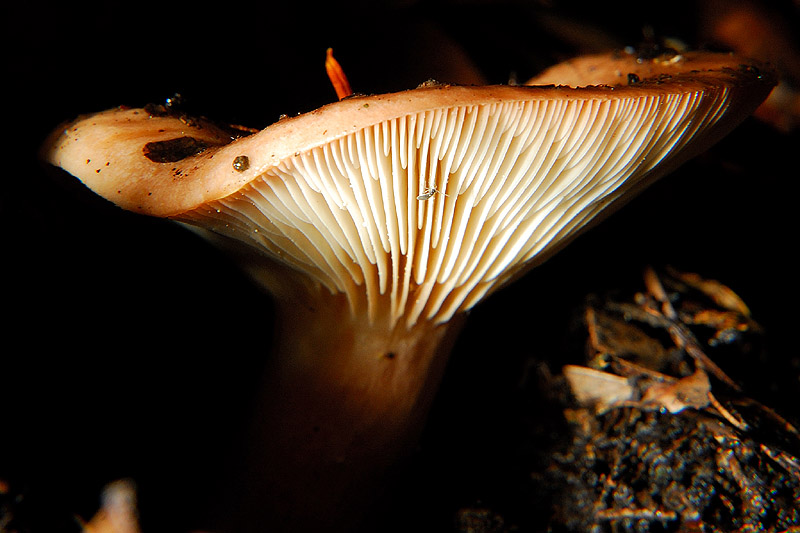
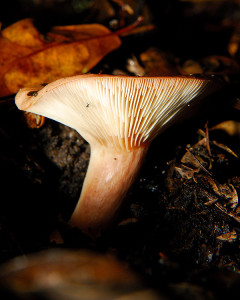
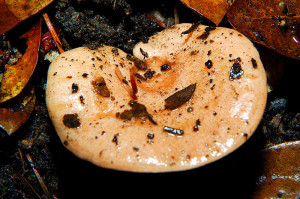
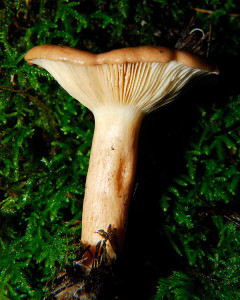
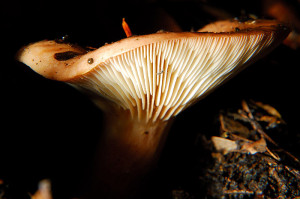
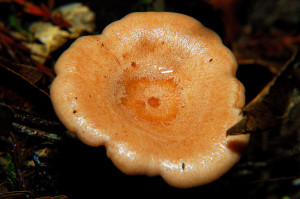








Hi! Fenway Bartholomule and I have seen fit to bestow upon you the Stylish Blogger award! Find the details here:
http://www.braysofourlives.com/2011/01/honor-and-privilegethe-stylish-blogger.html
If you choose to accept this accolade, the powers that be ask that you do the following:
1) link back to the blogger that awarded it to you (in this case, Fenway);
2) list seven things about you that we might not already know;
3) pass the fun on by recognizing, on your blog, up to 15 of your favorite newly-discovered bloggers;
4) let your nominees know by posting on their blogs.
Thanks, and keep on bloggin’!
Thank you Marnie and Fenway, very much appreciated!
Dear Clare, Happy New Year!!
I must confess that I have never shown much interest in mushroom harvesting in England whereas in Hungary it has been of great intrigue. There one can present the day’s foraging contents to licensed fungi inspectors who will advise upon the edibility or otherwise of one’s findings. I do so love eating wild mushrooms…quite a different taste from the cultivated varieties.
I love the idea of licensed fungi inspectors. I don’t hunt mushrooms to eat them, but many here do (I buy my wild mushrooms from someone that knows what they’re doing). There are so many look-a-like mushrooms that I’m sure a service such as that would prevent quite a number of accidental poisonings!
These mushrooms are really a piece of nature’s art. So beautiful in form.
That’s one of the reasons I like to photograph them. I’m especially fascinated with their gill structures. Unfortunately it was a bit dark where I shot these, but it is a pretty mushroom, for a beige one 😉
The first thing that caught my eye is your weather forecast of 70degrees! It’ll be May before we have that.
Another interesting mushroom that I’d never heard of. My 4 year old now squats down to check for fairies under any mushroom we see. I’ve told her not to touch them since we don’t know which ones are poisonous.
70F and it’s getting warmer in the week! Don’t laugh, but I may actually have to water part of the garden before the end of this week…in JANUARY! I’ve just transplanted about 40 young rosemary plants, and it’s getting a bit dry out there! I haven’t checked for fairies under the mushrooms…I’ll have to peek next time 😉
Looks like you know your mushrooms fairly well! Enjoyed reading about this Lactarius mushroom. Every once and a while I find the blue bleeding Lactarius mushrooms.
We have a blue-green Lactarius here, that I think is Lactarius deliciosus. By the time I saw them they were looking a little too far decayed, but quite a startling color compared the drab brown leaves on the ground.
How lovely Clare, to be able to walk around your property and find fungi! I have at least two feet of snow everywhere. I am happy that you will be able to start gardening!! How exciting. I so enjoy these post as I want to learn more about the fungi growing here. You inspire me! Thanks for sharing your knowledge. Your photos are wonderful too!
I am fortunate to mushroom hunt with my camera, and never actually leave the property. I suspect you can do the same where you are. It’s always fun to go out right after a rain and see what’s popping up!
A ‘heat wave’ is in my forecast. Temps are supposed to go to the low 30sF in the next couple of days.
Mushrooms generally give me a headache. Not from eating but attempting to identify them can be a real pain.
I’ll have to slit a couple next season. It really won’t help me with the Lactarius around here but at least I can have fun seeing them ooze.
Identification can be a headache. I must have 20 potential blog posts about fungi, but I have no idea what they are 😉
Hi Clare, What Edith wrote about Hungary is also the case in Germany: you can present the mushrooms you’ve collected to an expert to see if they’re edible. In your case, this probably wouldn’t be necessary, as you’re such an expert yourself! Love your title photo. Cheers, Barbara
Oh, I’m no expert, not by a long stretch, but I am having fun learning. For every mushroom I can identify, there are many I can’t, yet. Even the ‘experts’ can’t identify some species without using a microscope. Fortunately though, some that grow in this area are more distinctive. It’s all those little brown mushrooms (LBMs) that are impossible to tell apart!
Beautiful specimen!
Thanks FG 🙂
Clare, I love fungi~and your photos and posts are a joy to read. Although, we have lichens, mosses and other fungi on decaying wood at clay and limestone. ~The only mushrooms I see are toadstools after heavy rains. I do dream of finding morels when we take walks in nearby woodlands. Spotting them would be cool. gail
I haven’t delved into our mosses and lichens yet. We had lot of both a couple of weeks ago, but our dry weather has already desiccated a lot of the mosses. I hope we’ll get at least a little more rain soon, but right now the 10 day forecast is clear. I agree, finding a Morel would be cool. I found Chanterelles on the property last year, but as yet, have never spotted a Morel. Someday…I hope…
You are blessed, Clare … I see it’s 67º! ( – 11 leaving the lake yesterday AM and over a foot + of snow). I adore mushrooms/fungi, fun to photograph (and some, like our precious morels) to eat. I love to walk the woods in spring … you are so lucky. Thank you for sharing, as always, a delightful/informative post.
I’ve been finding all sorts of fungus all over the place, but due to lack of identification skills I won’t even touch them! What a shame ‘cos I know I’m missing out…
Very cool, Clare! I learned another mushroom we don’t have here. We have lots of Lactarius species here in the oak/pine woods around us. My favorite for its weirdness factor is the blue one, Lactarius indigo.
And guess what? I got a mushroom guide for Christmas. Finally. See how you’ve inspired me? The guide tells me the Lactarius indigo around here are edible — although the color is distinctly unappetizing to me.
hi, xanthogalactus…now that is a noble name if ever there was one…lovely post as ever….
I guess we’ll never see that one on this coast but I do see a lot of milky caps throughout the year. We found a few yummy ones over the summer that I hope we’ll run into again. Good to know about the yellow sap!
Aren’t there some lovely words associated with fungi! “Glabrous”, “stipe” “viscid” “decurrent” “spore” etc… I love ’em.
I’m getting quite interested in fungi myself. Recently discovered Visual Fungi website (link on my blog) which has been a great help in identifying some I have found.
I’m glad your weather is drying out. We’ve had some sunny days too, and it does get the gardening juices flowing!
Your fungi photos are lovely; you have certainly awakened my appreciation of these plants.